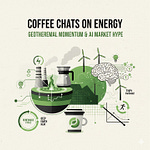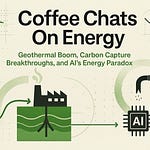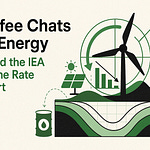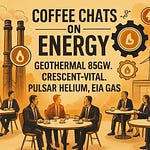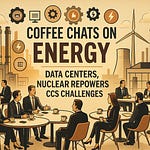Episode Length: ~17 minutes
Episode Summary
In this episode of Coffee Chats on Energy, the hosts unpack three major themes shaping today’s energy landscape: Google and Brookfield’s landmark hydro power agreement, the sweeping policy shifts of the One Big Beautiful Bill Act (OBBBA), and the evolving outlook for Direct Lithium Extraction (DLE). The conversation highlights how hyperscalers are reshaping power markets, how policy changes are creating both headwinds and opportunities across renewables and low-carbon fuels, and how lithium supply chains are inching closer to commercial viability despite pricing challenges.
Topics Covered
Google–Brookfield Hydro Agreement
3 GW of hydropower secured, equivalent to three large nuclear reactors.
Significance of reliable, dispatchable, low-carbon energy for hyperscalers.
Re-licensing and life extension of legacy assets.
Growing willingness of large tech companies to pay premiums for non-energy attributes (reliability, sustainability).
Market impact of locking up high-quality assets in long-term PPAs.
Hydropower Landscape
U.S. has ~100 GW of installed hydro; only ~3% of dams generate electricity.
Potential to add ~12 GW by powering non-electrified dams.
Development challenges: environmental impact, high costs, long lead times.
Parallels with nuclear as proven, scalable, but politically challenging technology.
One Big Beautiful Bill Act (OBBBA)
Major changes to tax credits affecting wind, solar, hydrogen, SAF, RNG, and CCUS.
Analysis shows: 30% of solar and 57% of wind in the Lower 48 remain viable without credits.
Implications for project pipelines, timelines, and offtake strategies.
CCUS and carbon-related technologies emerge as winners; hydrogen faces mixed outcomes.
Potential surge of projects to meet shortened construction deadlines (2026).
Direct Lithium Extraction (DLE)
Insights from a Canadian DLE conference: low sentiment due to weak lithium prices.
Technology development continues; commercialization hoped for by ~2029.
Supermajors (Exxon, Oxy, Chevron, Equinor) entering the space, focused on U.S. brine resources.
U.S. brine concentrations (200 ppm+) vs. global benchmarks (Chile/Argentina ~1,500 ppm).
Economics challenging: E3 project CapEx estimated at $6B.
Leveraging existing infrastructure could improve viability.
Broader importance for domestic supply security and energy storage.
Key Takeaways
Tech giants are reshaping energy procurement—hyperscalers like Google are driving demand for reliable, low-carbon baseload assets, effectively changing market dynamics.
Hydropower remains underutilized—with only a fraction of U.S. dams producing electricity, untapped potential exists, but development faces major hurdles.
Policy shifts are disruptive but selective—the OBBBA creates winners (CCUS, RNG, certain fuels) and losers (many solar, wind, and hydrogen projects), with significant regional implications.
Lithium extraction is maturing—despite weak prices, technology is advancing, majors are investing, and commercialization is edging closer, signaling progress in critical minerals supply.
Energy transition complexity continues to expand—from power generation to minerals, the conversation underscores the interconnectedness of technology, policy, and global markets.
Coffee chats are casual conversations On Energy, hosted live on LinkedIn. Opinions are my own, not investment advice or views of my employer.


